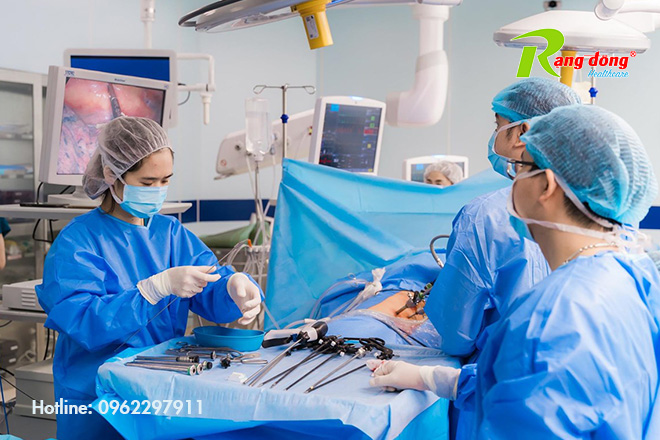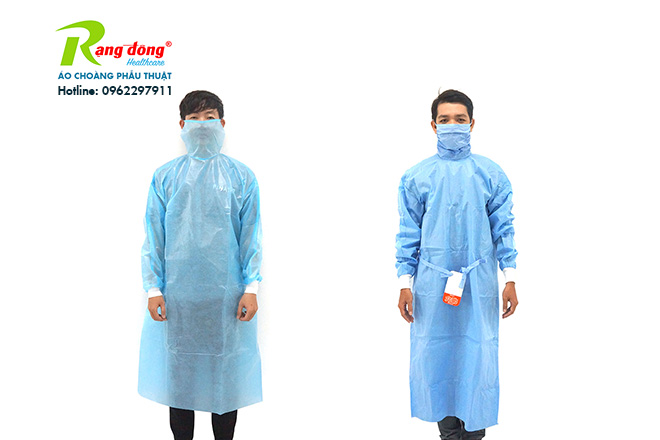The types of surgical gowns safe for patients Product information 27/05/2023
Rang Dong Healthcare Company’s surgical gowns are a noteworthy choice when seeking quality and suitable surgical attire. Rang Dong Healthcare is a trusted brand in the medical field, committed to providing reliable and high-quality products.

Surgical gowns, ensuring safety for patients, play a crucial role in the preparation and execution of surgical procedures. They serve to protect not only the patient but also healthcare staff and the surrounding environment.
Safe surgical gowns are indispensable in ensuring the safety and quality of surgical care. They are not just part of the standard procedure but also play a vital role in creating favorable conditions for successful surgical operations.
Types of safe surgical gowns for patients Waterproof gowns and non-woven fabric gowns
Waterproof gowns: made from waterproof materials, often PVC or fabrics coated with waterproof layers. Due to their waterproof nature, these gowns prevent the penetration of fluids such as blood, body fluids, or other solutions into the wearer. This helps protect the patient from infection and keeps the wearer dry during the surgical process.

Non-woven fabric gowns: made from synthetic or natural fibers bonded together using non-woven technologies. With an open structure, non-woven fabric gowns are breathable, allowing air circulation to maintain comfort for the wearer during surgery. Additionally, this non-woven material can prevent bacteria and infectious agents from the wearer or the surrounding environment.
Both types of gowns feature protective and safe functions for patients during surgical procedures. The choice between waterproof gowns and non-woven fabric gowns depends on the requirements of the surgical process, the working environment, and the comfort of the wearer.
Antibacterial gowns
Antibacterial gowns are designed and manufactured with special features to prevent the growth and spread of bacteria and infectious agents. This is crucial in surgical procedures and healthcare, where hygiene and infection prevention are essential.
Antibacterial gowns are often made from materials with antibacterial properties or treated with antibacterial agents. Commonly used antibacterial agents may include natural antibacterial substances like silver, copper, or zinc, or synthetic antibacterial substances.
Antibacterial gowns play a vital role in preventing infection and protecting the health of patients and healthcare staff. They contribute to creating a safe and hygienic healthcare environment, instilling confidence and peace of mind for patients during care.
Ergonomic and comfortable gowns
Ergonomic and comfortable gowns are designed to meet the requirements for comfort and professionalism in a healthcare environment.
With a combination of ergonomic design and comfort, these gowns provide comfort and flexibility for the wearer during medical work. This not only enhances work efficiency but also creates favorable conditions for focusing on patient care.
Standards and regulations for surgical gowns
Standards and regulations for surgical gowns are established to ensure safety and hygiene in the healthcare environment. Here are some common standards and regulations related to surgical gowns:
- ASTM F2407-06 Standard: This standard sets requirements for the material, design, size, and performance of surgical gowns. It includes requirements for waterproofing, durability, and breathability of gowns.
- EN 13795 Standard: This European standard applies to medical products used in surgery. It specifies requirements for durability, breathability, waterproofness, and antibacterial properties of surgical gowns.
- World Health Organization (WHO) regulations: WHO provides guidelines on the hygiene and use of surgical gowns in healthcare facilities. These guidelines emphasize the use of single-use gowns and the classification, laundering, and storage of surgical gowns.
- Local health regulatory requirements: Each country or region may have its own regulations regarding surgical gowns. Local health regulatory agencies often provide regulations on standards, hygiene requirements, and certification of surgical gowns.
These standards and regulations ensure that surgical gowns meet requirements for hygiene, safety, and performance in surgical and healthcare settings. Compliance with these standards and regulations is crucial to protecting the health of patients and healthcare staff, reducing the risk of infection and related complications.
Factors to consider when choosing surgical gowns
When choosing surgical gowns, several important factors need consideration to ensure safety, hygiene, and comfort. Here are some factors to consider when choosing surgical gowns:
- Material: The material of surgical gowns must meet hygiene and safety standards. Typically, surgical gowns are made from non-woven fabric, waterproof fabric, or antibacterial fabric. The material should be waterproof, easy to clean, and breathable to reduce sweating and enhance comfort for the wearer.
- Size and design: Surgical gowns need to be appropriately sized for the wearer to ensure a proper fit and comfort. They should also have an ergonomic design to maximize flexibility and natural movement during surgical activities.
- Durability and stability: Surgical gowns should have high durability to withstand friction and tension during work. They should also have sturdy stitching and secure details such as ties or buttons to ensure the gown does not loosen or slip during use.
- Antibacterial properties: Surgical gowns with antibacterial properties help prevent infection and inhibit the spread of bacteria. Using gowns with antibacterial properties can enhance safety and hygiene in the surgical environment.
- Convenience and flexibility: Surgical gowns should feature convenient elements such as pockets for holding tools, zippers, or ties for easy wearing and removal. This enhances convenience and efficiency during work.
- Compliance with standards and regulations: Ensure that the chosen surgical gown complies with healthcare industry standards and regulations. This ensures the gown meets quality and safety requirements.
- Brand and supply source: When selecting surgical gowns, consider reputable and reliable suppliers in the healthcare industry. Well-known brands often commit to quality standards, ensuring the reliability of their products.
- Flexibility and versatility: Surgical gowns can be flexible and versatile to accommodate various types of surgeries and medical procedures. They should be compatible with other medical equipment such as masks, protective eyewear, and gloves, creating a comprehensive protection system for the wearer and the patient.
- Feedback from users: Reviews and feedback from those who have used surgical gowns can provide valuable information about the characteristics and effectiveness of the product. Sharing experiences from healthcare experts and other healthcare staff can help you choose the most suitable gown for your needs.
- Value and cost: Lastly, consider the value and cost of surgical gowns. Research available options on the market, comparing quality, features, and prices to make an informed and economical decision.
Rang Dong Healthcare’s surgical gowns meet standards and regulations for safety, hygiene, and performance in the healthcare environment. They are designed with waterproof, easy-to-clean, and antibacterial materials, preventing infection and ensuring patient safety.
Choosing the right surgical gown plays a crucial role in ensuring safety, hygiene, and performance in the healthcare environment. A suitable surgical gown helps prevent infection and the spread of bacteria, ensuring hygiene and safety for patients. It also provides comfort and confidence for healthcare staff, enhancing work efficiency and maintaining a professional image.

Selecting the appropriate surgical gown requires careful consideration of factors such as material, size, durability, antibacterial properties, ergonomic design, and compliance with standards. A quality surgical gown must be made from waterproof, easy-to-clean, and antibacterial materials to prevent infection and ensure patient safety. The size should fit the wearer, ensuring a proper fit and comfort. The stitching should be secure, with fixed details to prevent the gown from loosening or slipping during use. Additionally, the surgical gown must comply with healthcare industry standards to ensure quality and safety.






